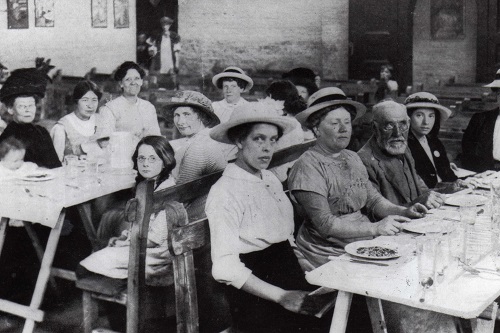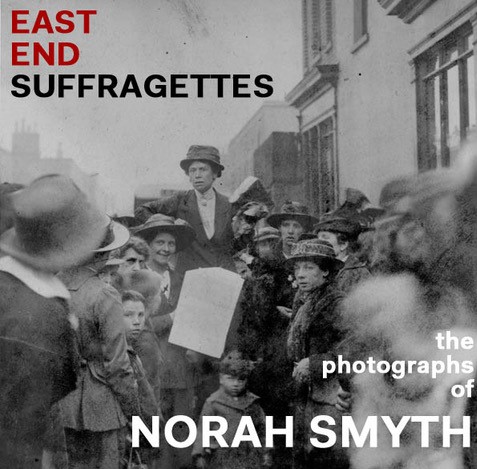By
Zena Howard
Unseen Suffragette photographs return to London’s East End after 100 years
A unique exhibition of photographs by suffragette Norah Smyth opens at London’s Four Corners Gallery this autumn. These remarkable photographs, taken 100 years ago, will be exhibited for the first time and just a stones-throw from where they were taken. They reveal the little-known story of the radical East London suffragettes.
Norah Smyth (1874-1963) was a central figure in Sylvia Pankhurst’s East London Federation of Suffragettes (ELFS), living and working with her in Bow. A talented artist and organiser, Smyth used her photographic skills to provide images for the ELFS newspaper, The Woman’s Dreadnought, alongside promotional postcards and catalogues, focusing in particular on local women and children living in poverty. One hundred years on, these compelling photographs offer an intimate record of Sylvia Pankhurst and the ELFS’ activities in 1914-18, an extraordinary moment in women’s social history.
Sylvia Pankhurst’s ELFS was a breakaway from the better-known Women’s Social and Political Union (WSPU), led by her mother and sister Emmeline and Christabel Pankhurst. The WSPU ceased campaigning for the vote at the outset of the First World War and threw itself behind the war effort. By contrast, the ELFS maintained an anti-war stance, and continued to fight for the vote and working women’s rights throughout the conflict. Faced by increasing wartime poverty in East London, they set up cost price restaurants, babies’ milk clinics, nurseries and a cooperative toy factory, run largely by and for local women. Alongside the vote, they campaigned for equal pay, a living wage and better housing; helping support profound social change from their headquarters at The Women’s Hall on 400 Old Ford Road in Bow, where Norah Smyth and Sylvia Pankhurst also lived.
East End Suffragettes: the photographs of Norah Smyth, includes over 100 original photographs, generously loaned by the International Institute of Social History in Amsterdam, alongside letters, documents and memorabilia in Sylvia Pankhurst’s archive. A free programme of talks and walks accompanies the exhibition.
Carla Mitchell, Development Director at Four Corners, says:
“We are delighted to exhibit Norah Smyth’s original photographs as they return to the East End for the first time. The East London Federation of the Suffragettes were a remarkable group of women whose story is little-known. As the centenary of women’s right to vote is celebrated nationally we aim to help East End communities discover the amazing suffrage stories on their doorstep.”
Helen Pankhurst, grand-daughter of Sylvia Pankhurst says:
“These unique photographs celebrate the spirit of East End women, unknown activists who worked alongside Sylvia for social change. Their actions truly represented the suffragette slogan ‘Deeds not Words’.”
Stuart Hobley, Head of Heritage Lottery Fund London, says:
“We’re delighted to support this timely project, which will reveal a significant but untold dimension of suffragette history. Thanks to National Lottery players, the legacy of these extraordinary and community-spirited women will be celebrated through a programme of activities, so we can all learn this both locally and important heritage for the first time.”
About women’s suffrage
In February 1918 the Representation of the People Act enfranchised women over 30, subject to a small property qualification, extending the right to vote to 8.4 million women in the UK – around 40 per cent of the total population. The Act also extended the right to vote to men aged 21 and over, whether or not they owned property. The Parliament (Qualification of Women) Act 1918 passed in November 1918, allowing women to be elected to Parliament. Women first voted on 14 December 1918. In July 1928 the Equal Franchise Act finally gave equal voting rights to women at the age of 21.
East London Federation of Suffragettes
Sylvia Pankhurst broke with the Women’s Social and Political Union (WSPU), the main suffragette party led by her mother and sister (Emmeline and Christabel Pankhurst) in 1913, to concentrate her efforts on alleviating the extreme poverty of women and children in London’s East End. Her new organisation, the East London Federation of Suffragettes, campaigned for radical social changes for women as well as the vote. At the outbreak of the First World War the WSPU ceased their campaigning in favour of the war effort. By contrast, the ELFS maintained a radical pacifist stance, and continued to promote the cause throughout the war.
International Institute of Social History
Work and labour relations deeply influence how we live. IISH examines how these relations develop globally over time. The IISH is a unique institute, serving science and society on a global scale. At an international level, we generate and offer reliable information and insights about the (long-term) origins, effects and consequences of social inequality.
To promote this, we form an international hub for social historians worldwide. We offer and produce historical sources and data, facilitate social-history research and collaborate internationally in ground breaking research projects. Moreover, by preserving the heritage of often-oppressed social movements, the Institute serves the quality of the world’s memory. The IISH is one of the world’s leading research institutes on social history. Since 1979 the IISH has been an institute of the Royal Netherlands Academy of Arts and Sciences (KNAW). www.iisg.amsterdam
The Women’s Hall project
The exhibition forms part of The Women’s Hall, a Heritage Lottery Fund project that celebrates the history of the East London Federation of Suffragettes 100 years after women in the UK first gained the vote. https://eastendwomensmuseum.org/the-womens-hall/ Activities include:
- The Women’s Hall exhibition (Tower Hamlets Local History Library & Archives, 29 May-20 October 2018) evokes the interior of the original Hall. Visitors can learn about the ELFS and the First World War in the East End and attend events and workshops. A pop-up community kitchen serves hot meals for the public at set times.
- A ‘Suffrage in the East End’ Education Pack, and digitized archive materials made available at Tower Hamlets Local History Library & Archives.
- The Modern Suffragette photography project for mothers runs at Four Corners in autumn 2018. Further information: https://www.eventbrite.com/e/modern-suffragette-photo-project-open-day-tickets-50178673764
East End Suffragettes: the photography of Norah Smyth
Exhibition at Four Corners Gallery
2 November – 9 February 2019, Tues-Sat: 10.00-6.00. Admission free
121 Roman Road, London E2 0QN
Nearest tube: Bethnal Green, Central Line
A programme of talks and local walks accompanies the exhibition. Further information: http://www.fourcornersfilm.co.uk/East-End-Suffragettes – again free
Photos reproduced with kind permission of Paul Isolani Smyth from the Estelle Sylvia Pankhurst collection at the International Institute of Social History, Amsterdam.
Four Corners is a creative centre for film and photography, committed to promoting community-wide participation for over 40 years. Its programme seeks to support projects that engage with social and cultural themes, and open up perspectives for audiences, particularly in East London. http://www.fourcornersfilm.co.uk



No Comments Yet!
You can be first to comment this post!